Effective Team Working and Communication
VerifiedAdded on 2023/01/07
|10
|2796
|1
AI Summary
This document discusses the importance of effective team working and communication in organizations. It explores different models of communication, such as Shannon and Weaver and Berlo's model. It also covers various communication skills, including verbal communication, non-verbal communication, and listening skills. Improve your teamwork and communication skills with Desklib.
Contribute Materials
Your contribution can guide someone’s learning journey. Share your
documents today.
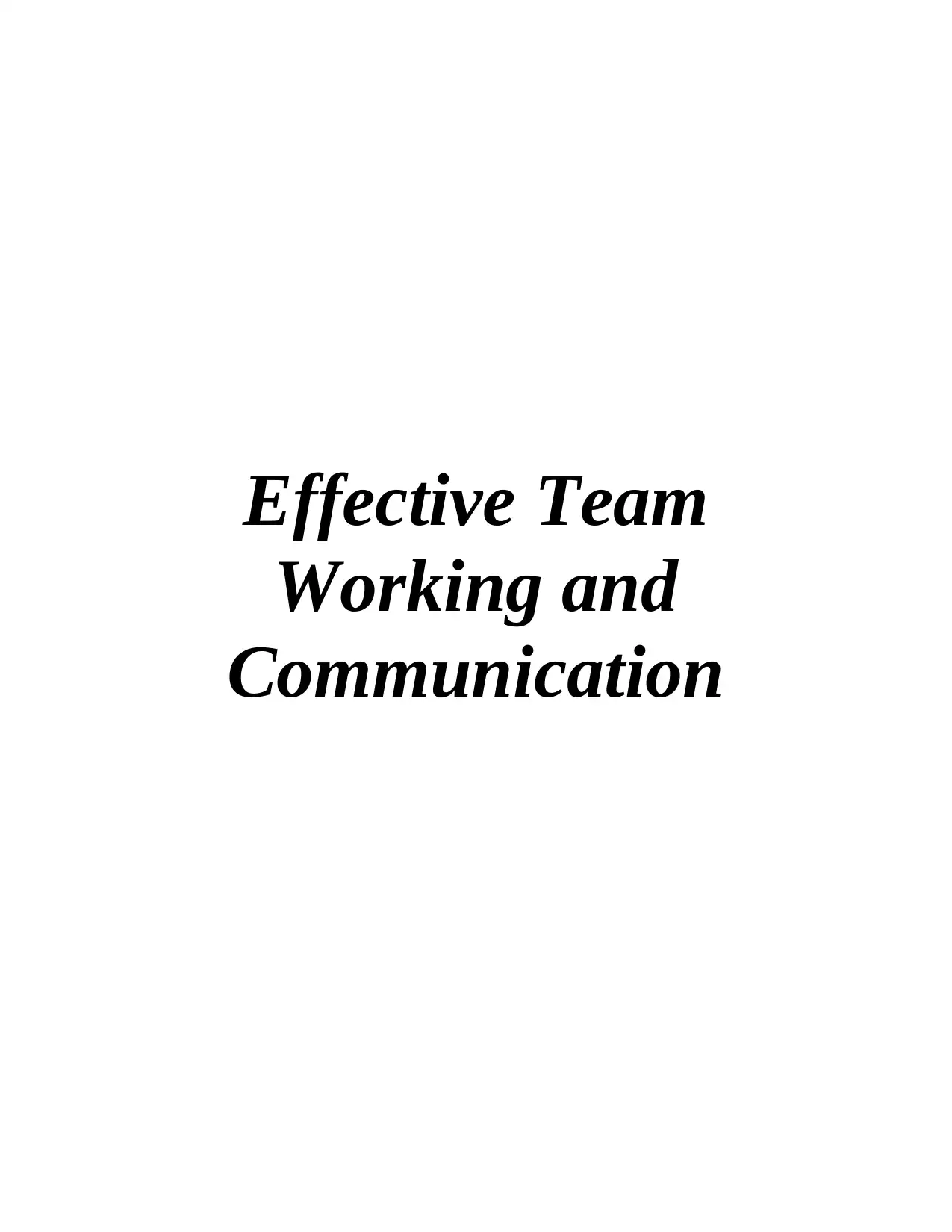
Effective Team
Working and
Communication
Working and
Communication
Secure Best Marks with AI Grader
Need help grading? Try our AI Grader for instant feedback on your assignments.
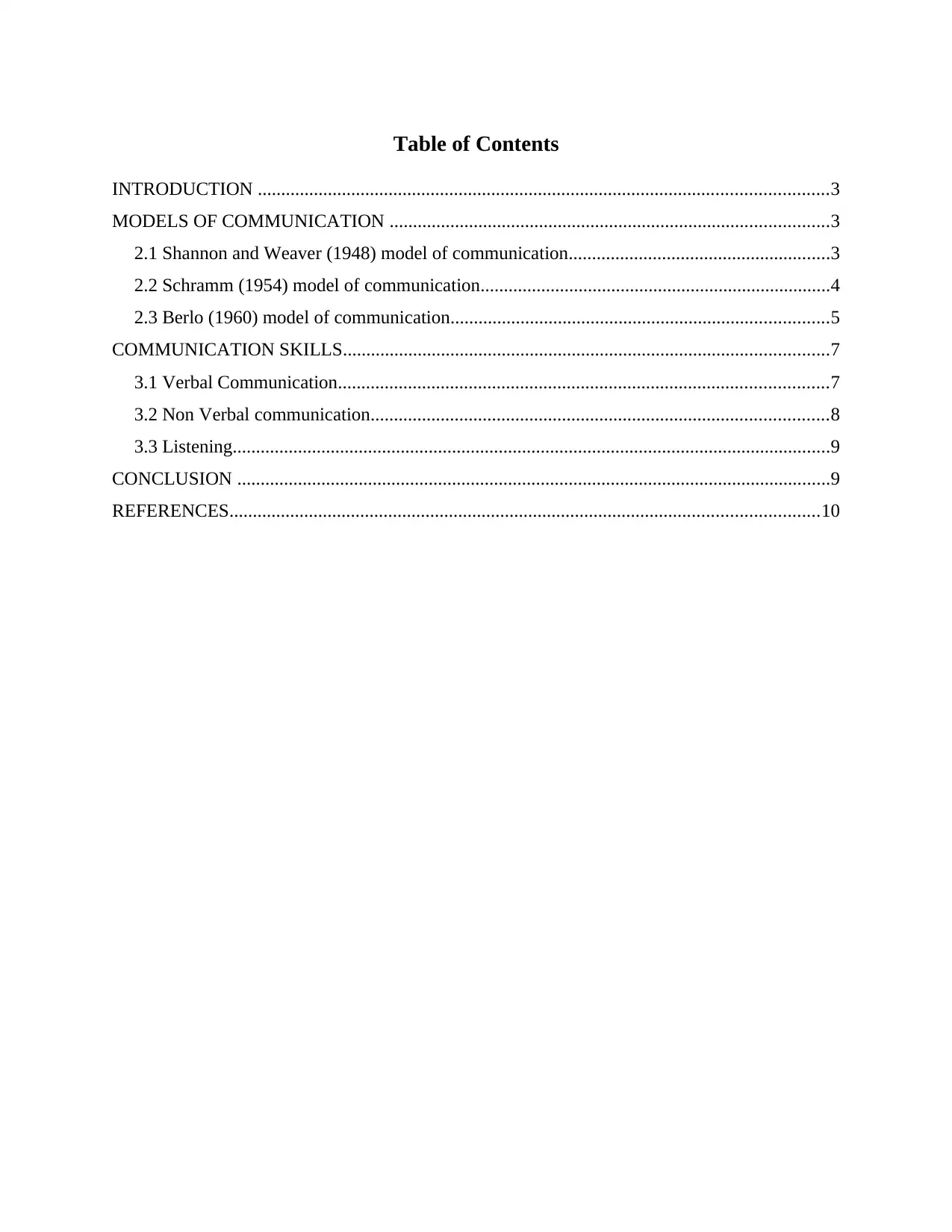
Table of Contents
INTRODUCTION ..........................................................................................................................3
MODELS OF COMMUNICATION ..............................................................................................3
2.1 Shannon and Weaver (1948) model of communication........................................................3
2.2 Schramm (1954) model of communication...........................................................................4
2.3 Berlo (1960) model of communication.................................................................................5
COMMUNICATION SKILLS........................................................................................................7
3.1 Verbal Communication.........................................................................................................7
3.2 Non Verbal communication..................................................................................................8
3.3 Listening................................................................................................................................9
CONCLUSION ...............................................................................................................................9
REFERENCES..............................................................................................................................10
INTRODUCTION ..........................................................................................................................3
MODELS OF COMMUNICATION ..............................................................................................3
2.1 Shannon and Weaver (1948) model of communication........................................................3
2.2 Schramm (1954) model of communication...........................................................................4
2.3 Berlo (1960) model of communication.................................................................................5
COMMUNICATION SKILLS........................................................................................................7
3.1 Verbal Communication.........................................................................................................7
3.2 Non Verbal communication..................................................................................................8
3.3 Listening................................................................................................................................9
CONCLUSION ...............................................................................................................................9
REFERENCES..............................................................................................................................10
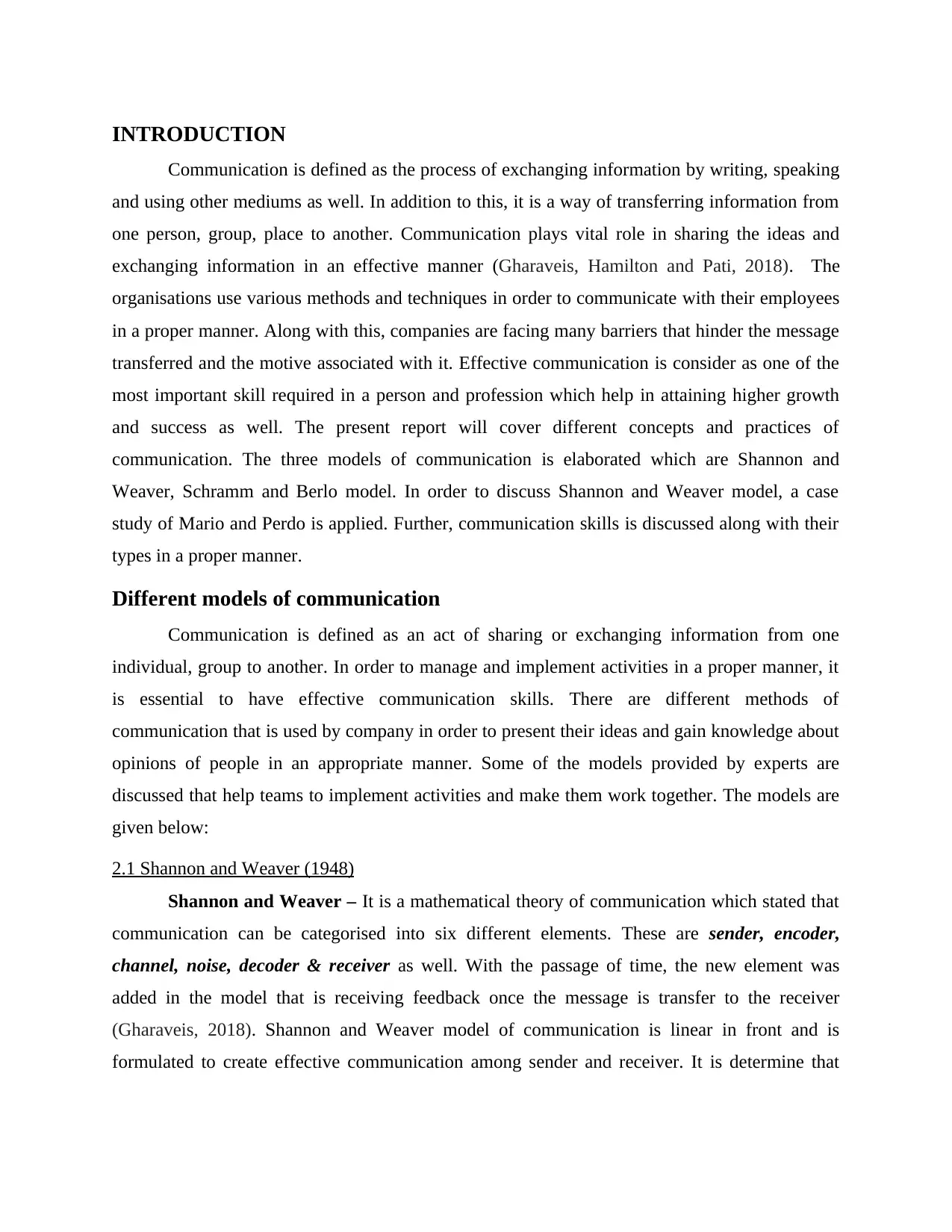
INTRODUCTION
Communication is defined as the process of exchanging information by writing, speaking
and using other mediums as well. In addition to this, it is a way of transferring information from
one person, group, place to another. Communication plays vital role in sharing the ideas and
exchanging information in an effective manner (Gharaveis, Hamilton and Pati, 2018). The
organisations use various methods and techniques in order to communicate with their employees
in a proper manner. Along with this, companies are facing many barriers that hinder the message
transferred and the motive associated with it. Effective communication is consider as one of the
most important skill required in a person and profession which help in attaining higher growth
and success as well. The present report will cover different concepts and practices of
communication. The three models of communication is elaborated which are Shannon and
Weaver, Schramm and Berlo model. In order to discuss Shannon and Weaver model, a case
study of Mario and Perdo is applied. Further, communication skills is discussed along with their
types in a proper manner.
Different models of communication
Communication is defined as an act of sharing or exchanging information from one
individual, group to another. In order to manage and implement activities in a proper manner, it
is essential to have effective communication skills. There are different methods of
communication that is used by company in order to present their ideas and gain knowledge about
opinions of people in an appropriate manner. Some of the models provided by experts are
discussed that help teams to implement activities and make them work together. The models are
given below:
2.1 Shannon and Weaver (1948)
Shannon and Weaver – It is a mathematical theory of communication which stated that
communication can be categorised into six different elements. These are sender, encoder,
channel, noise, decoder & receiver as well. With the passage of time, the new element was
added in the model that is receiving feedback once the message is transfer to the receiver
(Gharaveis, 2018). Shannon and Weaver model of communication is linear in front and is
formulated to create effective communication among sender and receiver. It is determine that
Communication is defined as the process of exchanging information by writing, speaking
and using other mediums as well. In addition to this, it is a way of transferring information from
one person, group, place to another. Communication plays vital role in sharing the ideas and
exchanging information in an effective manner (Gharaveis, Hamilton and Pati, 2018). The
organisations use various methods and techniques in order to communicate with their employees
in a proper manner. Along with this, companies are facing many barriers that hinder the message
transferred and the motive associated with it. Effective communication is consider as one of the
most important skill required in a person and profession which help in attaining higher growth
and success as well. The present report will cover different concepts and practices of
communication. The three models of communication is elaborated which are Shannon and
Weaver, Schramm and Berlo model. In order to discuss Shannon and Weaver model, a case
study of Mario and Perdo is applied. Further, communication skills is discussed along with their
types in a proper manner.
Different models of communication
Communication is defined as an act of sharing or exchanging information from one
individual, group to another. In order to manage and implement activities in a proper manner, it
is essential to have effective communication skills. There are different methods of
communication that is used by company in order to present their ideas and gain knowledge about
opinions of people in an appropriate manner. Some of the models provided by experts are
discussed that help teams to implement activities and make them work together. The models are
given below:
2.1 Shannon and Weaver (1948)
Shannon and Weaver – It is a mathematical theory of communication which stated that
communication can be categorised into six different elements. These are sender, encoder,
channel, noise, decoder & receiver as well. With the passage of time, the new element was
added in the model that is receiving feedback once the message is transfer to the receiver
(Gharaveis, 2018). Shannon and Weaver model of communication is linear in front and is
formulated to create effective communication among sender and receiver. It is determine that

such model is famous for its efficiency and state how messages and views of people shared can
be wring because of misinterpretation take place among sender and receiver.
The Shannon and Weaver model will be discussed by the help of case study of Mario and
Pedro. Maria is the wife of Pedro who is working on a building site. The wife Maria phoned
Pedro and said that when you’re coming home, see if you can get me a chicken. When Pedro go
to the home, he took of coat and shoes and went to the kitchen. After this, Maria asked Pedro
“where is the chicken” and he said “what chicken”. Maria stated that he called you to get chicken
on your way home but the message that was interpret by Pedro is “when I come home I will see
you in the kitchen”.
From the above case study, it is easily analysed that there is a language difference and
barrier among the sender and receiver. As per the case, an understanding by Shannon and Weaver
model is provided which is the sender & receivers language barrier and difference. In addition to
this, the speed of delivering message is high that hinders the information that is need to be
delivered. Moreover, the noise is also the issue as Pedro is working in the building site (Graham,
2018). Further, after the calling Maria just cut the call without confirming the message or asking
for feedback that help in delivering right message to Pedro. This all occurred issues that impact
on the conversation and communication which is being done among the two person.
2.2 Schramm (1954)
Schramm – As per this model, coding & decoding are two important aspects of an
effective statement. It stated that communication is incomplete or ineffective till the
communicator receives feedback from the recipient. In addition to this, it is used to analyse how
communication among two individuals works at the time they interact or exchanging ideas and
information as well. It is a cyclical model of communication which is based on the belief that
communication is a two-way street. Schramm believes that a person culture, background and
knowledge plays vital role in communication as individual belong from different culture share
information in their own way and understanding them in a proper manner assist in gaining
positive outcomes. The elements involved in this model is given below:
Sender (Encoder): A person who encodes or send the message to another person. It is
important that source has to be clear while sending message (Kim, 2019). In addition to this, the
information deliver is accurate, relevant and useful for the receiver. For ensuring message read
by recipient, it is to be encoded which means it is essential for the recipient to know who the
be wring because of misinterpretation take place among sender and receiver.
The Shannon and Weaver model will be discussed by the help of case study of Mario and
Pedro. Maria is the wife of Pedro who is working on a building site. The wife Maria phoned
Pedro and said that when you’re coming home, see if you can get me a chicken. When Pedro go
to the home, he took of coat and shoes and went to the kitchen. After this, Maria asked Pedro
“where is the chicken” and he said “what chicken”. Maria stated that he called you to get chicken
on your way home but the message that was interpret by Pedro is “when I come home I will see
you in the kitchen”.
From the above case study, it is easily analysed that there is a language difference and
barrier among the sender and receiver. As per the case, an understanding by Shannon and Weaver
model is provided which is the sender & receivers language barrier and difference. In addition to
this, the speed of delivering message is high that hinders the information that is need to be
delivered. Moreover, the noise is also the issue as Pedro is working in the building site (Graham,
2018). Further, after the calling Maria just cut the call without confirming the message or asking
for feedback that help in delivering right message to Pedro. This all occurred issues that impact
on the conversation and communication which is being done among the two person.
2.2 Schramm (1954)
Schramm – As per this model, coding & decoding are two important aspects of an
effective statement. It stated that communication is incomplete or ineffective till the
communicator receives feedback from the recipient. In addition to this, it is used to analyse how
communication among two individuals works at the time they interact or exchanging ideas and
information as well. It is a cyclical model of communication which is based on the belief that
communication is a two-way street. Schramm believes that a person culture, background and
knowledge plays vital role in communication as individual belong from different culture share
information in their own way and understanding them in a proper manner assist in gaining
positive outcomes. The elements involved in this model is given below:
Sender (Encoder): A person who encodes or send the message to another person. It is
important that source has to be clear while sending message (Kim, 2019). In addition to this, the
information deliver is accurate, relevant and useful for the receiver. For ensuring message read
by recipient, it is to be encoded which means it is essential for the recipient to know who the
Secure Best Marks with AI Grader
Need help grading? Try our AI Grader for instant feedback on your assignments.
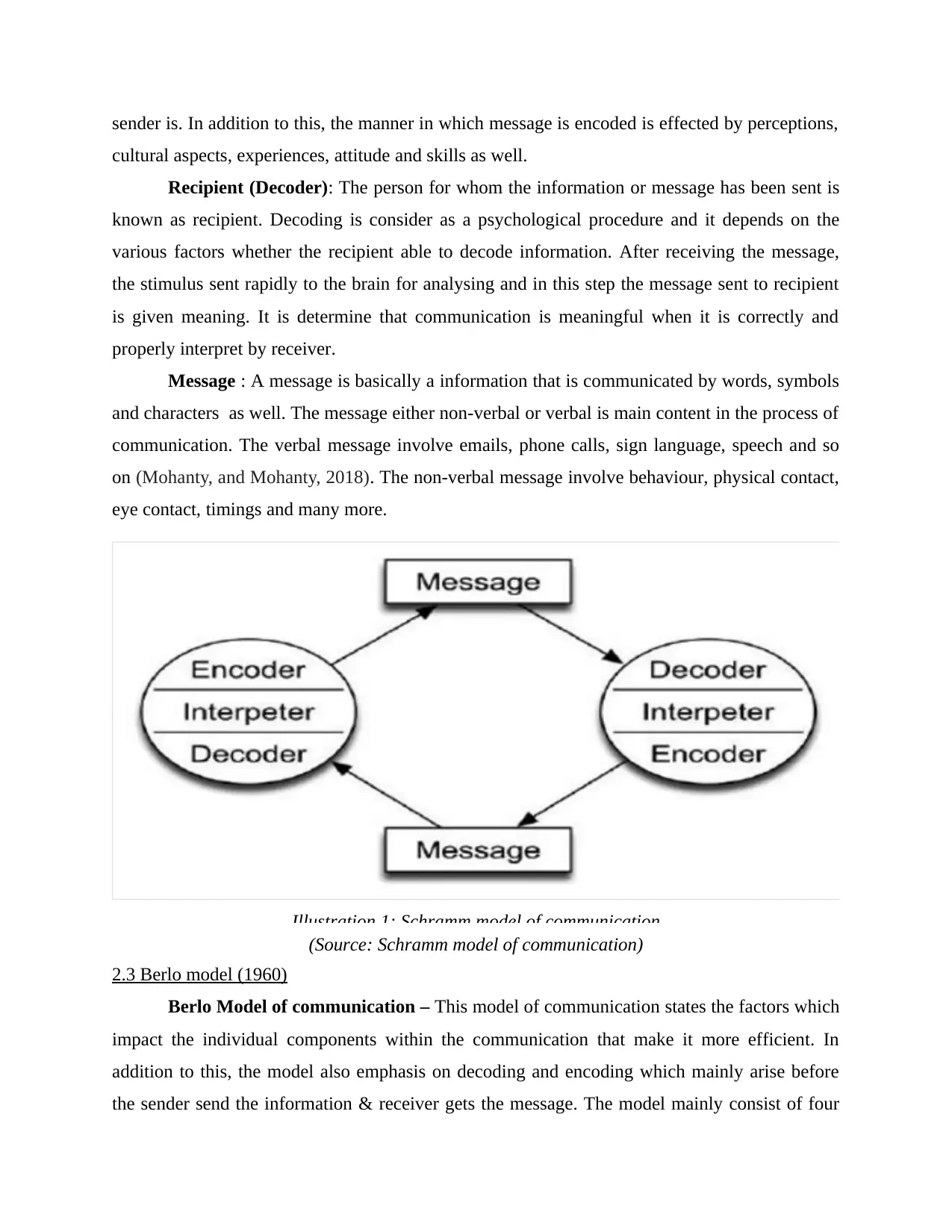
sender is. In addition to this, the manner in which message is encoded is effected by perceptions,
cultural aspects, experiences, attitude and skills as well.
Recipient (Decoder): The person for whom the information or message has been sent is
known as recipient. Decoding is consider as a psychological procedure and it depends on the
various factors whether the recipient able to decode information. After receiving the message,
the stimulus sent rapidly to the brain for analysing and in this step the message sent to recipient
is given meaning. It is determine that communication is meaningful when it is correctly and
properly interpret by receiver.
Message : A message is basically a information that is communicated by words, symbols
and characters as well. The message either non-verbal or verbal is main content in the process of
communication. The verbal message involve emails, phone calls, sign language, speech and so
on (Mohanty, and Mohanty, 2018). The non-verbal message involve behaviour, physical contact,
eye contact, timings and many more.
Illustration 1: Schramm model of communication
(Source: Schramm model of communication)
2.3 Berlo model (1960)
Berlo Model of communication – This model of communication states the factors which
impact the individual components within the communication that make it more efficient. In
addition to this, the model also emphasis on decoding and encoding which mainly arise before
the sender send the information & receiver gets the message. The model mainly consist of four
cultural aspects, experiences, attitude and skills as well.
Recipient (Decoder): The person for whom the information or message has been sent is
known as recipient. Decoding is consider as a psychological procedure and it depends on the
various factors whether the recipient able to decode information. After receiving the message,
the stimulus sent rapidly to the brain for analysing and in this step the message sent to recipient
is given meaning. It is determine that communication is meaningful when it is correctly and
properly interpret by receiver.
Message : A message is basically a information that is communicated by words, symbols
and characters as well. The message either non-verbal or verbal is main content in the process of
communication. The verbal message involve emails, phone calls, sign language, speech and so
on (Mohanty, and Mohanty, 2018). The non-verbal message involve behaviour, physical contact,
eye contact, timings and many more.
Illustration 1: Schramm model of communication
(Source: Schramm model of communication)
2.3 Berlo model (1960)
Berlo Model of communication – This model of communication states the factors which
impact the individual components within the communication that make it more efficient. In
addition to this, the model also emphasis on decoding and encoding which mainly arise before
the sender send the information & receiver gets the message. The model mainly consist of four
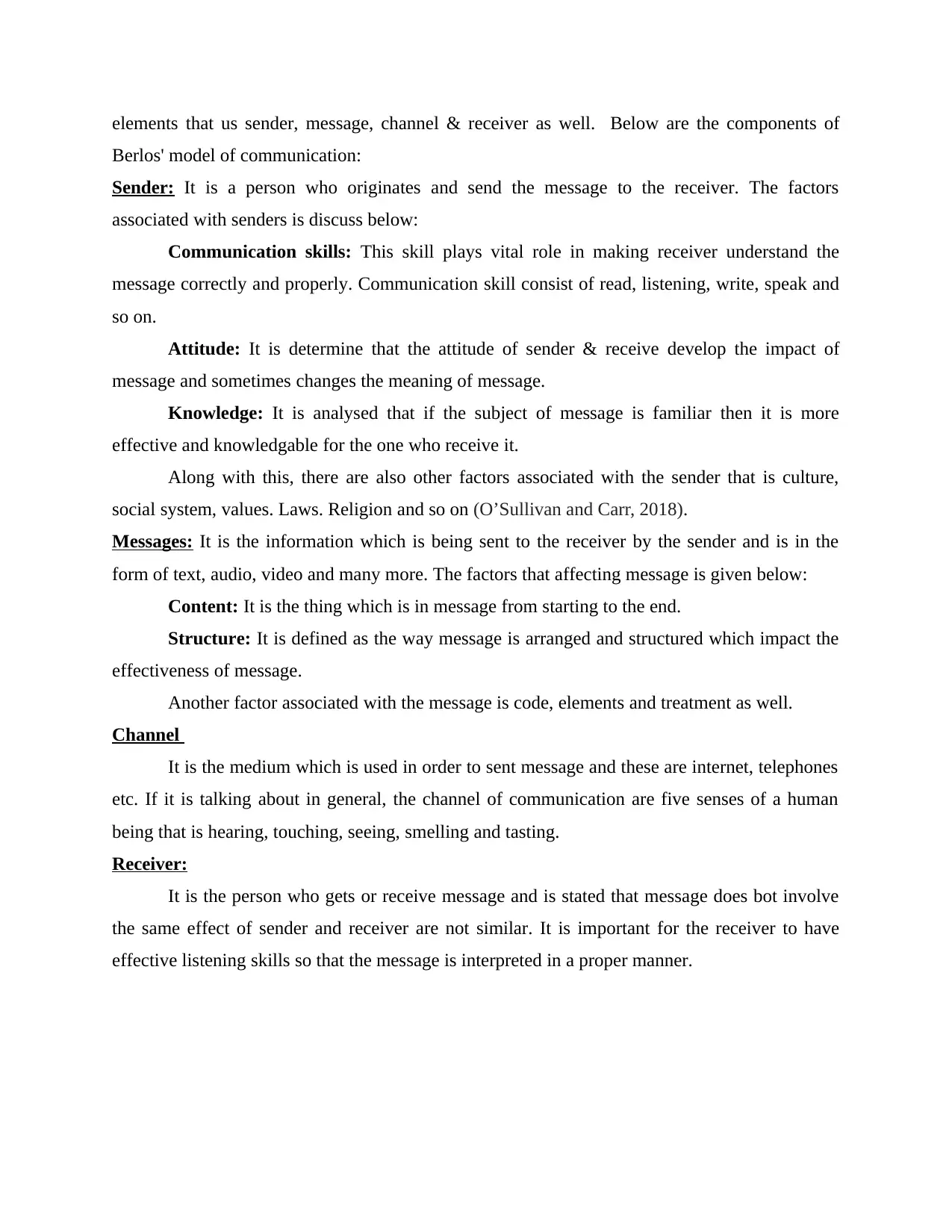
elements that us sender, message, channel & receiver as well. Below are the components of
Berlos' model of communication:
Sender: It is a person who originates and send the message to the receiver. The factors
associated with senders is discuss below:
Communication skills: This skill plays vital role in making receiver understand the
message correctly and properly. Communication skill consist of read, listening, write, speak and
so on.
Attitude: It is determine that the attitude of sender & receive develop the impact of
message and sometimes changes the meaning of message.
Knowledge: It is analysed that if the subject of message is familiar then it is more
effective and knowledgable for the one who receive it.
Along with this, there are also other factors associated with the sender that is culture,
social system, values. Laws. Religion and so on (O’Sullivan and Carr, 2018).
Messages: It is the information which is being sent to the receiver by the sender and is in the
form of text, audio, video and many more. The factors that affecting message is given below:
Content: It is the thing which is in message from starting to the end.
Structure: It is defined as the way message is arranged and structured which impact the
effectiveness of message.
Another factor associated with the message is code, elements and treatment as well.
Channel
It is the medium which is used in order to sent message and these are internet, telephones
etc. If it is talking about in general, the channel of communication are five senses of a human
being that is hearing, touching, seeing, smelling and tasting.
Receiver:
It is the person who gets or receive message and is stated that message does bot involve
the same effect of sender and receiver are not similar. It is important for the receiver to have
effective listening skills so that the message is interpreted in a proper manner.
Berlos' model of communication:
Sender: It is a person who originates and send the message to the receiver. The factors
associated with senders is discuss below:
Communication skills: This skill plays vital role in making receiver understand the
message correctly and properly. Communication skill consist of read, listening, write, speak and
so on.
Attitude: It is determine that the attitude of sender & receive develop the impact of
message and sometimes changes the meaning of message.
Knowledge: It is analysed that if the subject of message is familiar then it is more
effective and knowledgable for the one who receive it.
Along with this, there are also other factors associated with the sender that is culture,
social system, values. Laws. Religion and so on (O’Sullivan and Carr, 2018).
Messages: It is the information which is being sent to the receiver by the sender and is in the
form of text, audio, video and many more. The factors that affecting message is given below:
Content: It is the thing which is in message from starting to the end.
Structure: It is defined as the way message is arranged and structured which impact the
effectiveness of message.
Another factor associated with the message is code, elements and treatment as well.
Channel
It is the medium which is used in order to sent message and these are internet, telephones
etc. If it is talking about in general, the channel of communication are five senses of a human
being that is hearing, touching, seeing, smelling and tasting.
Receiver:
It is the person who gets or receive message and is stated that message does bot involve
the same effect of sender and receiver are not similar. It is important for the receiver to have
effective listening skills so that the message is interpreted in a proper manner.

Illustration 2: Berlo model of communication, 2019
(Source: Berlo model of communication, 2019)
COMMUNICATION SKILLS
3.1 Verbal Communication
Verbal communication is defined as a tool to conduct communication in the form of
words & sounds. In addition to this, it is is an effective communication source which help a
person to deliver message in a more appropriate and expressed way (Popovski, 2018). In case of
sender, it make use of verbal communication that is evaluated by receiver and as per this, the
feedback is provide to the sender. By the assistance of verbal communication, the sender can
easily share its ideas and express their feelings to the receiver in a proper manner. There are
various forms of verbal communication and these are oral interaction, presentation, speech,
(Source: Berlo model of communication, 2019)
COMMUNICATION SKILLS
3.1 Verbal Communication
Verbal communication is defined as a tool to conduct communication in the form of
words & sounds. In addition to this, it is is an effective communication source which help a
person to deliver message in a more appropriate and expressed way (Popovski, 2018). In case of
sender, it make use of verbal communication that is evaluated by receiver and as per this, the
feedback is provide to the sender. By the assistance of verbal communication, the sender can
easily share its ideas and express their feelings to the receiver in a proper manner. There are
various forms of verbal communication and these are oral interaction, presentation, speech,
Paraphrase This Document
Need a fresh take? Get an instant paraphrase of this document with our AI Paraphraser
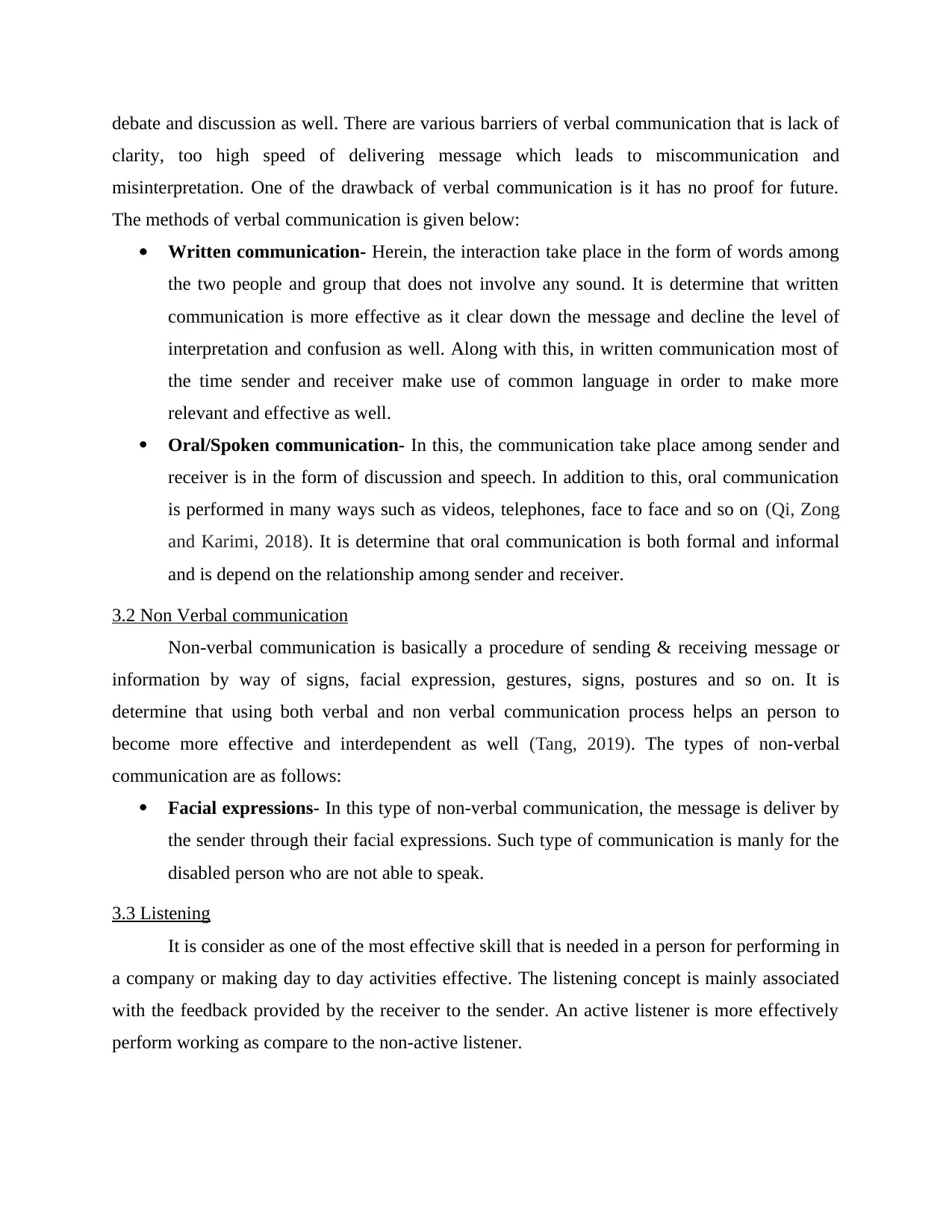
debate and discussion as well. There are various barriers of verbal communication that is lack of
clarity, too high speed of delivering message which leads to miscommunication and
misinterpretation. One of the drawback of verbal communication is it has no proof for future.
The methods of verbal communication is given below:
Written communication- Herein, the interaction take place in the form of words among
the two people and group that does not involve any sound. It is determine that written
communication is more effective as it clear down the message and decline the level of
interpretation and confusion as well. Along with this, in written communication most of
the time sender and receiver make use of common language in order to make more
relevant and effective as well.
Oral/Spoken communication- In this, the communication take place among sender and
receiver is in the form of discussion and speech. In addition to this, oral communication
is performed in many ways such as videos, telephones, face to face and so on (Qi, Zong
and Karimi, 2018). It is determine that oral communication is both formal and informal
and is depend on the relationship among sender and receiver.
3.2 Non Verbal communication
Non-verbal communication is basically a procedure of sending & receiving message or
information by way of signs, facial expression, gestures, signs, postures and so on. It is
determine that using both verbal and non verbal communication process helps an person to
become more effective and interdependent as well (Tang, 2019). The types of non-verbal
communication are as follows:
Facial expressions- In this type of non-verbal communication, the message is deliver by
the sender through their facial expressions. Such type of communication is manly for the
disabled person who are not able to speak.
3.3 Listening
It is consider as one of the most effective skill that is needed in a person for performing in
a company or making day to day activities effective. The listening concept is mainly associated
with the feedback provided by the receiver to the sender. An active listener is more effectively
perform working as compare to the non-active listener.
clarity, too high speed of delivering message which leads to miscommunication and
misinterpretation. One of the drawback of verbal communication is it has no proof for future.
The methods of verbal communication is given below:
Written communication- Herein, the interaction take place in the form of words among
the two people and group that does not involve any sound. It is determine that written
communication is more effective as it clear down the message and decline the level of
interpretation and confusion as well. Along with this, in written communication most of
the time sender and receiver make use of common language in order to make more
relevant and effective as well.
Oral/Spoken communication- In this, the communication take place among sender and
receiver is in the form of discussion and speech. In addition to this, oral communication
is performed in many ways such as videos, telephones, face to face and so on (Qi, Zong
and Karimi, 2018). It is determine that oral communication is both formal and informal
and is depend on the relationship among sender and receiver.
3.2 Non Verbal communication
Non-verbal communication is basically a procedure of sending & receiving message or
information by way of signs, facial expression, gestures, signs, postures and so on. It is
determine that using both verbal and non verbal communication process helps an person to
become more effective and interdependent as well (Tang, 2019). The types of non-verbal
communication are as follows:
Facial expressions- In this type of non-verbal communication, the message is deliver by
the sender through their facial expressions. Such type of communication is manly for the
disabled person who are not able to speak.
3.3 Listening
It is consider as one of the most effective skill that is needed in a person for performing in
a company or making day to day activities effective. The listening concept is mainly associated
with the feedback provided by the receiver to the sender. An active listener is more effectively
perform working as compare to the non-active listener.
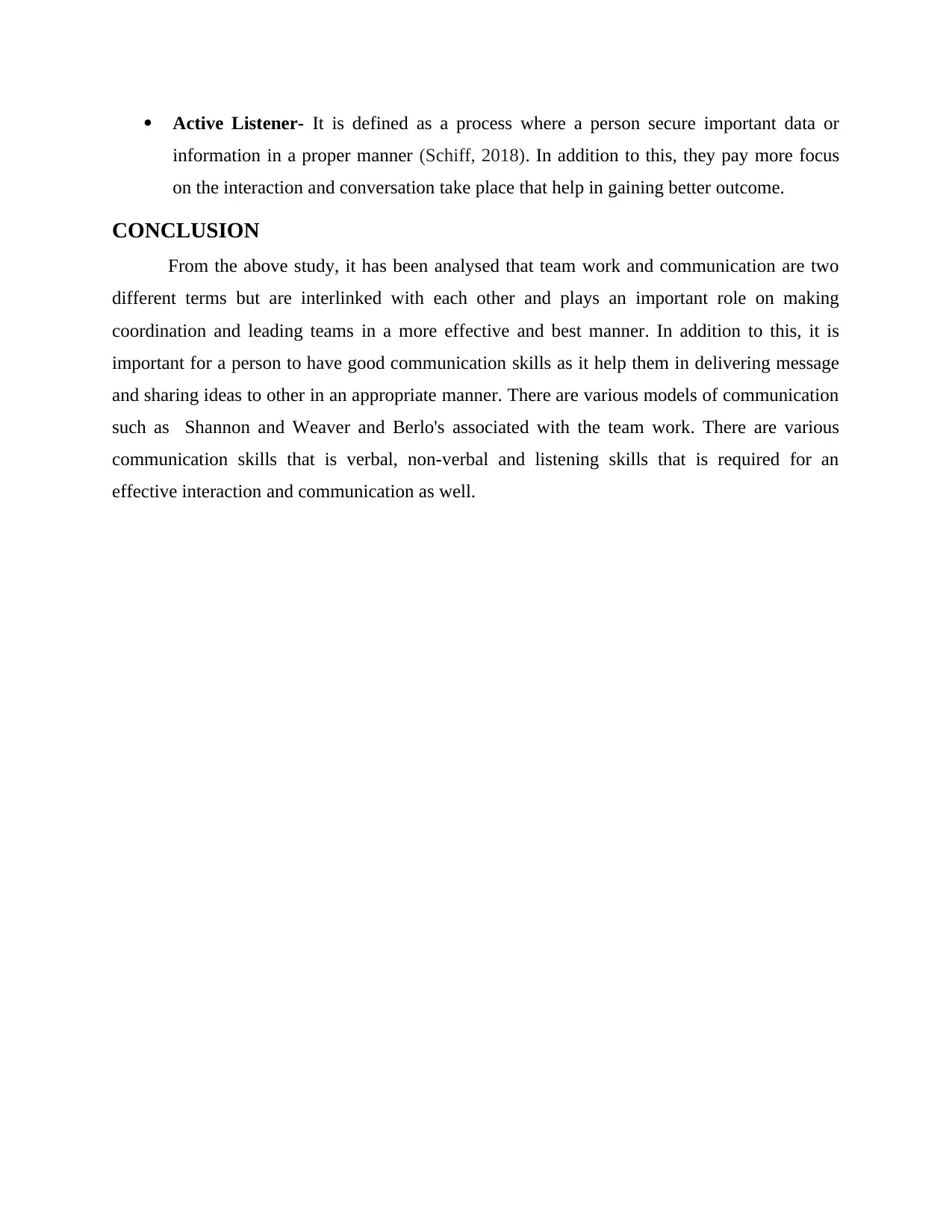
Active Listener- It is defined as a process where a person secure important data or
information in a proper manner (Schiff, 2018). In addition to this, they pay more focus
on the interaction and conversation take place that help in gaining better outcome.
CONCLUSION
From the above study, it has been analysed that team work and communication are two
different terms but are interlinked with each other and plays an important role on making
coordination and leading teams in a more effective and best manner. In addition to this, it is
important for a person to have good communication skills as it help them in delivering message
and sharing ideas to other in an appropriate manner. There are various models of communication
such as Shannon and Weaver and Berlo's associated with the team work. There are various
communication skills that is verbal, non-verbal and listening skills that is required for an
effective interaction and communication as well.
information in a proper manner (Schiff, 2018). In addition to this, they pay more focus
on the interaction and conversation take place that help in gaining better outcome.
CONCLUSION
From the above study, it has been analysed that team work and communication are two
different terms but are interlinked with each other and plays an important role on making
coordination and leading teams in a more effective and best manner. In addition to this, it is
important for a person to have good communication skills as it help them in delivering message
and sharing ideas to other in an appropriate manner. There are various models of communication
such as Shannon and Weaver and Berlo's associated with the team work. There are various
communication skills that is verbal, non-verbal and listening skills that is required for an
effective interaction and communication as well.

REFERENCES
Gharaveis, A., Hamilton, D.K. and Pati, D., 2018. The impact of environmental design on
teamwork and communication in healthcare facilities: a systematic literature
review. HERD: Health Environments Research & Design Journal, 11(1), pp.119-137.
Gharaveis, A., and et. al., 2018. The impact of visibility on teamwork, collaborative
communication, and security in emergency departments: An exploratory study. HERD:
Health Environments Research & Design Journal, 11(4), pp.37-49.
Graham, S., 2018. A revised writer (s)-within-community model of writing. Educational
Psychologist, 53(4), pp.258-279.
Kim, S., 2019. The process model of corporate social responsibility (CSR) communication: CSR
communication and its relationship with consumers’ CSR knowledge, trust, and corporate
reputation perception. Journal of Business Ethics, 154(4), pp.1143-1159.
Mohanty, A. and Mohanty, S., 2018. The impact of communication and group dynamics on
teamwork effectiveness: The case of service sector organisations. Academy of Strategic
Management Journal, 17(4), pp.1-14.
O’Sullivan, P. B. and Carr, C. T., 2018. Masspersonal communication: A model bridging the
mass-interpersonal divide. New Media & Society, 20(3), pp.1161-1180.
Popovski, and et. al., 2018. Wireless access for ultra-reliable low-latency communication:
Principles and building blocks. Ieee Network, 32(2), pp.16-23.
Qi, W., Zong, G. and Karimi, H. R., 2018. $\mathscr {L} _\infty $ Control for Positive Delay
Systems With Semi-Markov Process and Application to a Communication Network
Model. IEEE Transactions on Industrial Electronics, 66(3), pp.2081-2091.
Schiff, L., and et. al., 2018. Teaching and sustaining a shared mental model for intraoperative
communication and teamwork. Obstetrics & Gynecology, 132, p.58S.
Tang, T., and et. al., 2019. Using an electronic tool to improve teamwork and interprofessional
communication to meet the needs of complex hospitalized patients: A mixed methods
study. International journal of medical informatics, 127, pp.35-42.
Online:
Schramm model of communication. 2020. [Online]. Available through:
<https://www.qsstudy.com/business-studies/schramms-model-communication>
Berlo model of communication. 2019. [Online]. Available through:
<https://www.businesstopia.net/communication/berlo-model-communication
Gharaveis, A., Hamilton, D.K. and Pati, D., 2018. The impact of environmental design on
teamwork and communication in healthcare facilities: a systematic literature
review. HERD: Health Environments Research & Design Journal, 11(1), pp.119-137.
Gharaveis, A., and et. al., 2018. The impact of visibility on teamwork, collaborative
communication, and security in emergency departments: An exploratory study. HERD:
Health Environments Research & Design Journal, 11(4), pp.37-49.
Graham, S., 2018. A revised writer (s)-within-community model of writing. Educational
Psychologist, 53(4), pp.258-279.
Kim, S., 2019. The process model of corporate social responsibility (CSR) communication: CSR
communication and its relationship with consumers’ CSR knowledge, trust, and corporate
reputation perception. Journal of Business Ethics, 154(4), pp.1143-1159.
Mohanty, A. and Mohanty, S., 2018. The impact of communication and group dynamics on
teamwork effectiveness: The case of service sector organisations. Academy of Strategic
Management Journal, 17(4), pp.1-14.
O’Sullivan, P. B. and Carr, C. T., 2018. Masspersonal communication: A model bridging the
mass-interpersonal divide. New Media & Society, 20(3), pp.1161-1180.
Popovski, and et. al., 2018. Wireless access for ultra-reliable low-latency communication:
Principles and building blocks. Ieee Network, 32(2), pp.16-23.
Qi, W., Zong, G. and Karimi, H. R., 2018. $\mathscr {L} _\infty $ Control for Positive Delay
Systems With Semi-Markov Process and Application to a Communication Network
Model. IEEE Transactions on Industrial Electronics, 66(3), pp.2081-2091.
Schiff, L., and et. al., 2018. Teaching and sustaining a shared mental model for intraoperative
communication and teamwork. Obstetrics & Gynecology, 132, p.58S.
Tang, T., and et. al., 2019. Using an electronic tool to improve teamwork and interprofessional
communication to meet the needs of complex hospitalized patients: A mixed methods
study. International journal of medical informatics, 127, pp.35-42.
Online:
Schramm model of communication. 2020. [Online]. Available through:
<https://www.qsstudy.com/business-studies/schramms-model-communication>
Berlo model of communication. 2019. [Online]. Available through:
<https://www.businesstopia.net/communication/berlo-model-communication
1 out of 10
Related Documents
Your All-in-One AI-Powered Toolkit for Academic Success.
+13062052269
info@desklib.com
Available 24*7 on WhatsApp / Email
![[object Object]](/_next/static/media/star-bottom.7253800d.svg)
Unlock your academic potential
© 2024 | Zucol Services PVT LTD | All rights reserved.





